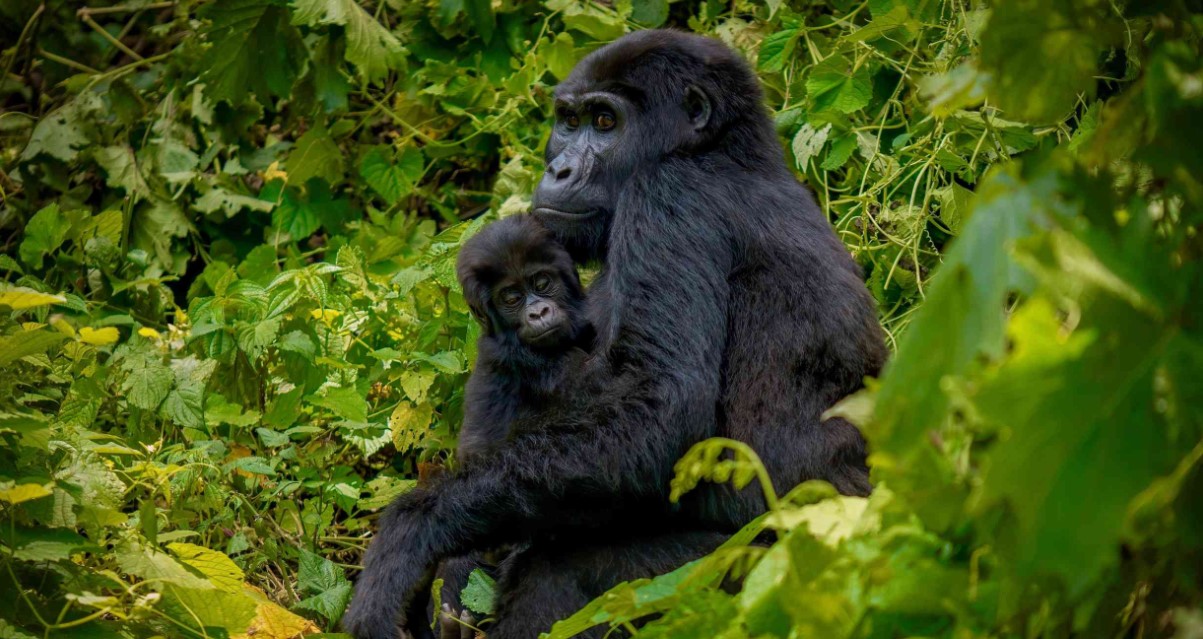Wildlife in Bwindi gorilla Forest National Park: One of the areas with an abundance of wildlife is the southwest of Uganda, where we find Bwindi Gorilla Park. With around 600 mountain gorillas living there, the park was officially recognized in 1991 and is said to be home to more than half of population of world’s mountain gorillas. There are 120 animal species, 11 primates, 350 bird species, 220 butterfly, 27 amphibian species, and 51 reptile species in Bwindi National Park.
Wildlife in Bwindi gorilla Forest National Park
Mountain gorillas: With over 600 mountain gorillas living in Bwindi Gorilla Forest National Park, the national park shelters the largest mountain gorilla population in the world. The four sectors of the Bwindi Gorilla Park to include; Nkuringo, Ruhija, Buhoma, and Rushaga are the home to mountain gorillas. Not only Mountain gorillas in the Bwindi Gorilla Park that have become habituated for tourism. In Bwindi Gorilla Park, 19 mountain gorilla families have become habituated and two gorilla groups are currently going through the process.
Birds: Bwindi Gorilla Park is home to 350 different species of birds, making it one of the top places in the nation for birdwatching. Of these birds, fourteen are unique to the Bwindi Gorilla Park, while 23 are indigenous to the Albertine region. Some of the bird species in Bwindi gorilla park include African green broadbill, shelley’s crimsonwing, grauer’s rush warbler, Rwenzori nightjar, yellow-eyed black flycatcher, Kivu ground thrush, white-tailed blue flycatcher, African emerald cuckoo, short-tailed warbler, strip breasted tit, archers robin char, giant kingfisher, common bulbul, black bee-eater, and grey cuckoo-shrike to mention but a few.
Mammals: The dense forests of Bwindi Gorilla Park is a home to over 120 species of mammals. After Queen Elizabeth National Park in western Uganda, Bwindi is the second national park with a large variety of mammal biodiversity. some of wildlife in Bwindi Gorilla Park include huge forest hogs, yellow-backed and black-fronted duikers, bats, civets,buffaloes, side-stripped jackals, bush pigs, and elephants.
Due of its status as one of the top birding spots, birdwatching is the second most popular activity in the Bwindi Impenetrable Forest National Park. Some of the top birding routes in Buhoma and Ruhija region provide views of 350 different bird species. In the Bwindi Gorilla Park, birdwatching excursions can be made via the Bamboo Zone Trail, the Buhoma Waterfall Trail, and the Mubwindi Swamp Trail.
The trekking activities in Bwindi Gorilla Park are led by armed ranger guides who lead the trekkers through the park’s trails. There’s an opportunity to encounter many park animals, including primates, birds, and plants. It takes two to seven hours to discover the mountain gorillas for gorilla trekking, but once you find the family you’ve been searching for, the rangers allow you to spend one hour with the animals for gorilla trekking and four hours for gorilla habituation.
In Bwindi Gorilla Park primate viewing begins at 8 a.m., when visitors are expected to meet at the park headquarters for a briefing from the park wardens. The trekkers are instructed on rules and guidelines governing trekking activities during the briefing. Eight individuals go gorilla trekking, while four people go gorilla habituation with the help of researchers, conservationists, and armed ranger guides.
Activities to do in Bwindi Gorilla Park
besides the abundance of Wildlife in Bwindi gorilla Forest National Park, the most popular activities are gorilla trekking and gorilla habituation. There are two gorilla families for habituation, Rushaga and Nkuringo, and 19 gorilla families available for trekking throughout the park’s four sectors. You need to obtain a gorilla trekking permit or gorilla habituation permit from the Uganda Wildlife Authority from a local tour operator in order to see the primates at the Bwindi Gorilla Park.
African olive-pigeon, petit’s cuckoo-shrike, African hill babbler, African citril, Rwenzori batis, blue-spotted wood dove, luhder’s bush-shrike, magpie manikin, tambourine dove, cassin’s flycatcher, African golden-breasted bunting, oriole finch, ansorge’s greenbul, white-throated greenbul, grey wagtail, snowy-crowned robin-chat, olive-breasted greenbul, cape wagtail, dusky twin spot, mountain wagtail, giant kingfisher, and yellow-fronted canary are among the birds that are frequently spotted in Bwindi.
Helmeted guinea fowl, green combec, elliot’s woodpecker, doherty’s bush-shrike, African pygmy kingfisher, Eurasian hobby, white spotted fluff tail, afed pigeon, short-tailed warbler, marsh tchagra, copper sunbird, palm nut vulture, papyrus canary, tit hylia, buff spotted woodpecker, sooty falcon, ayres hawk-eagle, dwarf honeyguide, black crake, buff spotted fluff tail, brown chested alethe, green hylia, western green tinkerbird, and fine banded woodpecker are some of the other bird species found in Bwindi forest.
The best way to explore the park’s features is to go on a nature walk in Bwindi Gorilla Park. Visitors can use the many nature walk routes in Bwindi Gorilla Park, which are escorted by armed ranger guides, to explore the park. The Buhoma Bamboo Trail, the Ivy River Trail, the Munyaga Waterfall Trail, the Muzabajiro Loop Trail, and the Mubwindi Swamp Trail are a some of the nature walk paths in the Bwindi Gorilla Park.
Experience Park animals like chimpanzees, mountain gorillas, elephants, buffaloes, giant forest hogs, red-tailed monkeys, blue monkeys, l’hoest monkeys, olive baboons, black and white colobus monkeys, amphibians, reptiles, butterflies, and various plant species by strolling along the nature walk trails.
What is the best time to visit Bwindi Gorilla Park
While visits to Bwindi Gorilla Park are possible throughout the year, some months are preferable to others. The best times to visit Bwindi Gorilla Park are during the dry months of June to September and December to February, which are distinguished by little to no rainfall that keeps the trekking trails dry, sparse vegetation that allows visitors to see the park’s animals clearly, and passable roads that lead to the park.
In the rainy months of March to May and October to November, tourists can still visit Bwindi Gorilla Park and take advantage of discounts on accommodation options. Travelers should be aware, though, that the park’s roads are passable and that there is an abundance of rainfall during the rainy season, which makes the hiking routes muddy and difficult and blocks views of the park’s wildlife.

